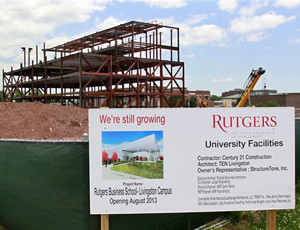With polls indicating that New Jersey voters know little or nothing about the “Building Our Future Act” on the Nov. 6 election ballots, boosters are planning a big rollout next week to promote passage of the $750-million bond measure to fund construction of higher-education facilities. The measure, which allows the state to borrow for new academic buildings and upgrades at research universities, public colleges and community colleges, is the first since 1988 that supporters were able to get on the ballot. If approved, the funds would be combined with existing bond proceeds of about $500 million to create a $1.2 billion capital fund, say state officials.
Supporters are optimistic the new measure will get voters’ blessing, although an early September Rutgers University poll showed that most had heard little or nothing about it. But Paul Shelly, a spokesman for the New Jersey Association of State Colleges and Universities (NJASCU), says the poll also showed 56% of voters would support the measure anyway. “That’s not as strong as a couple of years ago, but we’ll take it in this economy,” he says.
Proponents say N.J. higher-ed structures need to accommodate changing technologies and that outmoded facilities are a factor for nearly 30,000 high school graduates choosing colleges outside the state each year.
The measure would authorize new state bond funding only for academic facilities such as classrooms, labs, libraries and computer facilities. “Revenue-producing” facilities such as dorms, parking garages and stadiums would not be eligible.
“Some of these institutions have grown significantly in enrollment, and some are working with low-budget scattered buildings constructed at low cost in the 1970s,” Shelly tells ENR/NY. “Also, cutting-edge, hi-tech facilities are needed for science classrooms and labs, as many high schools now have more up to date facilities. Each college has a different story to tell.”
If the measure is enacted, schools will still need to provide a 25% match from other sources for any bond proceeds. “The required kick-in seems to be helping with public support for the bond,” Shelly says.
Even so, Peter J. McDonough, Rutgers vice president of public affairs, told the campus newspaper that the bond funding could save the university more than $100 million, savings that could translate into lower costs there.
Shelly notes that revenue-producing projects may gain from a state law enacted in August that will allow public-private finance ventures on campuses for the first time. Project developers must submit proposals for approval to the New Jersey Economic Development Authority by Aug. 1, 2013.
Shelly says this would pertain to projects “in which a private entity is to assume the full financial and administrative responsibility for the on-campus construction, reconstruction, repair, alteration, improvement, or extension of a building, structure, or facility of, or for the benefit of, the institution, provided that the project is financed in whole by the private entity and that the institution retains full ownership of the land upon which the project is completed.”
A publicity launch for the measure by a coalition of supporters, including industry groups, legislative leaders and former Republican Gov. Tom Kean, is set for Oct. 9, Shelly says.
A student coalition that aims to sign up thousands of new college-age voters across the state has also publicly supported the measure.






Post a comment to this article
Report Abusive Comment